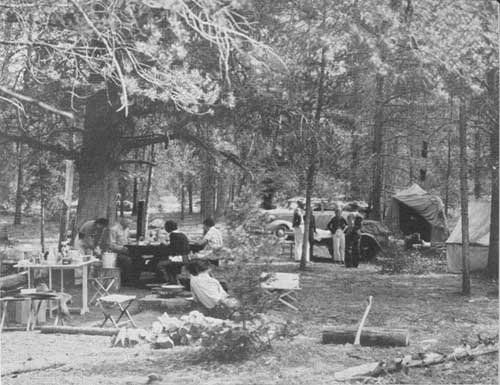|
Shoshone National Forest |

|
WILDLIFE OF THE FOREST
BIG GAME.—The Shoshone is the only forest in Wyoming in which all species of big game native to the State are found, with the exception of the whitetail deer. These include antelope, mule deer, elk, mountain sheep, moose, and black and grizzly bear. What may be even more surprising is that there are open seasons on all species—deer, elk, and bear under the regular license; antelope, mountain sheep, and moose under special permit. Another unusual feature about hunting on the Shoshone is that except for the southern part of the forest the regular hunting season is 60 days long, from September 15 to November 15. In addition, there is a spring bear season from May 1 to June 15, just after the bears come out of hibernation and their skins are best. State Game and Fish regulations frequently change from year to year. If you plan to go hunting, post yourself on the current regulations.

|
| A week-end party at one of the forest's improved campgrounds. F—386019 |
The Shoshone is a favorite rendezvous for nonresident hunters because it has the game, and the outfitters and guides. The State laws require that all nonresident big game hunters hire licensed outfitters and guides to conduct them.
The Forest Service is deeply concerned with the propagation and protection of game. This involves not only cooperating with State officers and enforcing the game laws, but providing game herds with sufficient and suitable range. Throughout the West the national forests supply most of the summer range for big game animals except antelope. The Shoshone Forest is no exception. Most national forests contain sufficient summer range for present game herds and some increases. However, the situation regarding winter range is different. Most of the land at the lower elevations where the game originally wintered is outside the forest. Much of it has been homesteaded and is in livestock ranches and farms. In many sections of the West game, especially deer and elk, are faced with the desperate choice of raiding ranches in the valleys and foothills or starving in the snowdrifts of the high mountains. In some instances the Forest Service has been able to provide winter game range by regulating grazing or eliminating livestock entirely from the ranges. Such an example can be found on the Shoshone on the Elk Fork, Sweetwater, Horse Creek, and Grizzly Creek drainages. This area furnishes winter range for the largest elk herd on the forest, and is reserved especially for it. In addition, several hundred deer also use this same range.
|
For the purpose of maintaining and preserving the big game herds within them, the State has established the Shoshone and Hoodoo State Game Preserves, where no hunting is permitted.
The Cody-Yellowstone Road passes through the Shoshone Preserve. During the summer months most of the animals, particularly deer, elk, and mountain sheep, are in the high country back from the road. Moose, however, are frequently seen along the river and occasionally deer and bear. During winter and spring, however, hundreds of deer and elk can be seen quietly feeding along the road. Mountain sheep are also frequently seen during these seasons.
Keep your camera loaded when passing through the forest. A shot of a big bull moose or a graceful deer makes just as good a trophy as a head or a hide, and the camera season is always open. It requires much more skill to stalk and shoot game with a camera than with a gun.
If you go hunting be a genuine sportsman by obeying the State laws, by putting out your smokes and campfires, and by leaving a clean camp.
FUR BEARERS.—In the old days of the fur brigade and trading posts the area now in the forest furnished its quota of furs, and it still produces some of the finest. The most valuable and most eagerly sought fur bearer is the marten. In addition, there are badger, muskrat, ermine, mink, red fox, coyote, and bobcat. There are also three other species which are protected, beaver, otter, and wolverine, which is extremely rare.
On the Shoshone the trappers are assigned to individual trapping allotments. Each man regards the allotment as his, because it is reissued to him year after year as long as he wishes to hold it and obeys the State and Federal laws. This system promotes harvesting the fur crop rather than mining it. In other words, the trapper realizes that he cannot take all of the animals but must leave a sufficient number to restock the allotment for future trapping. Each trapper is required to report to the proper officer all game law violations occurring within his territory.
FISHING.—Practically all suitable waters of the forest are stocked with fish. Species include the black spotted, rainbow, Eastern brook, and mackinaw trout, Montana grayling, and whitefish.
In recognition of the importance of keeping lakes and streams stocked the State Game and Fish Commission operates a fish hatchery near Cody, and practically all of its output is used in replenishing the waters of the forest. Additional assistance is rendered by the U. S. Bureau of Fisheries by furnishing planting stock from its Yellowstone Park, Crawford, Nebr., and Bozeman, Mont., hatcheries. Forest officers cooperate with representatives of these agencies in planting fish in forest waters. The forest maintains a specially built tank truck for transportation of fish into the mountain waters. Four rearing ponds have been constructed by the Forest Service in which fry and fingerling trout are kept until they are from 4 to 7 inches in length before being released. The percentage of survival of fish reared in such ponds is many times greater than when they are released in turbulent mountain streams before they are large enough to care for themselves.
| <<< Previous | <<< Contents>>> | Next >>> |
|
handbooks/shoshone/sec5.htm Last Updated: 19-Nov-2010 |